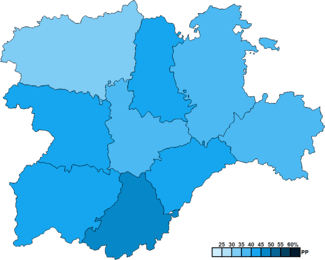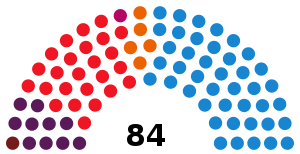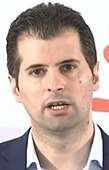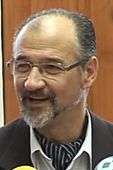Castilian-Leonese regional election, 2015
|
| |||||||||||||||||||||||||||||||||||||||||||||||||||||||||||||||||||||||||||||||||||||||||||||
| |||||||||||||||||||||||||||||||||||||||||||||||||||||||||||||||||||||||||||||||||||||||||||||
All 84 seats in the Cortes of Castile and León 43 seats needed for a majority | |||||||||||||||||||||||||||||||||||||||||||||||||||||||||||||||||||||||||||||||||||||||||||||
|---|---|---|---|---|---|---|---|---|---|---|---|---|---|---|---|---|---|---|---|---|---|---|---|---|---|---|---|---|---|---|---|---|---|---|---|---|---|---|---|---|---|---|---|---|---|---|---|---|---|---|---|---|---|---|---|---|---|---|---|---|---|---|---|---|---|---|---|---|---|---|---|---|---|---|---|---|---|---|---|---|---|---|---|---|---|---|---|---|---|---|---|---|---|
| Opinion polls | |||||||||||||||||||||||||||||||||||||||||||||||||||||||||||||||||||||||||||||||||||||||||||||
| Registered |
2,151,993 | ||||||||||||||||||||||||||||||||||||||||||||||||||||||||||||||||||||||||||||||||||||||||||||
| Turnout |
1,391,797 (64.7%) | ||||||||||||||||||||||||||||||||||||||||||||||||||||||||||||||||||||||||||||||||||||||||||||
| |||||||||||||||||||||||||||||||||||||||||||||||||||||||||||||||||||||||||||||||||||||||||||||
 Constituency results map for the Cortes of Castile and León | |||||||||||||||||||||||||||||||||||||||||||||||||||||||||||||||||||||||||||||||||||||||||||||
| |||||||||||||||||||||||||||||||||||||||||||||||||||||||||||||||||||||||||||||||||||||||||||||
The 2015 Castilian-Leonese regional election was held on Sunday, 24 May 2015, to elect the 9th Cortes of the Autonomous Community of Castile and León. All 84 seats in the Cortes were up for election. The election was held simultaneously with regional elections in twelve other autonomous communities and local elections all throughout Spain.
Overview
Electoral system
The Cortes of Castile and León were the devolved, unicameral legislature of the autonomous community of Castile and León, having legislative power in regional matters as defined by the Spanish Constitution and the Castilian-Leonese Statute of Autonomy, as well as the ability to vote confidence in or withdraw it from a President of the Junta.[1] Voting for the Cortes was on the basis of universal suffrage, which comprised all nationals over eighteen, registered in Castile and León and in full enjoyment of their political rights. Additionally, Castilian-Leonese people abroad were required to apply for voting before being permitted to vote, a system known as "begged" or expat vote (Spanish: Voto rogado).[2]
All members of the Cortes of Castile and León were elected using the D'Hondt method and a closed list proportional representation, with a threshold of 3 percent of valid votes—which included blank ballots—being applied in each constituency. Parties not reaching the threshold were not taken into consideration for seat distribution. Additionally, the use of the D'Hondt method might result in an effective threshold over three percent, depending on the district magnitude.[3] Seats were allocated to constituencies, corresponding to the provinces of Ávila, Burgos, León, Palencia, Salamanca, Segovia, Soria, Valladolid and Zamora. Each constituency was entitled to an initial minimum of three seats, being allocated one additional member per each 45,000 inhabitants or fraction greater than 22,500.[1][4]
The electoral law provided that parties, federations, coalitions and groupings of electors were allowed to present lists of candidates. However, groupings of electors were required to secure the signature of at least 1 percent of the electors registered in the constituency for which they sought election. Electors were barred from signing for more than one list of candidates. Concurrently, parties and federations intending to enter in coalition to take part jointly at an election were required to inform the relevant Electoral Commission within ten days of the election being called.[4][5][6]
Election date
The term of the Cortes of Castile and León expired four years after the date of their previous election, unless they were dissolved earlier. The election Decree was required to be issued no later than the twenty-fifth day prior to the date of expiry of parliament and published on the following day in the Official Gazette of Castile and León, with election day taking place on the fifty-fourth day from publication. The previous election was held on 22 May 2011, which meant that the legislature's term would have expired on 22 May 2015. The election Decree was required to be published no later than 28 April 2015, with the election taking place on the fifty-fourth day from publication, setting the latest possible election date for the Cortes on Sunday, 21 June 2015.[1][4][5][6]
The President of the Junta had the prerogative to dissolve the Cortes of Castile and León and call a snap election, provided that no motion of no confidence was in process and that dissolution did not occur either during the first legislative session or before one year had elapsed since a previous dissolution. In the event of an investiture process failing to elect a regional President within a two-month period from the first ballot, the Cortes were to be automatically dissolved and a fresh election called.[1]
Opinion polls
The table below lists voting intention estimates in reverse chronological order, showing the most recent first and using the dates when the survey fieldwork was done, as opposed to the date of publication. Where the fieldwork dates are unknown, the date of publication is given instead. The highest percentage figure in each polling survey is displayed with its background shaded in the leading party's colour. If a tie ensues, this is applied to the figures with the highest percentages. The "Lead" column on the right shows the percentage-point difference between the parties with the highest percentages in a given poll. When available, seat projections are also displayed below the voting estimates in a smaller font. 43 seats were required for an absolute majority in the Cortes of Castile and León.
- Color key:
Exit poll
| Polling firm/Commissioner | Fieldwork date | Sample size | Turnout | UPL | Lead | |||||||
|---|---|---|---|---|---|---|---|---|---|---|---|---|
| 2015 regional election | 24 May 2015 | N/A | 64.9 | 37.7 42 |
25.9 25 |
4.1 1 |
1.4 0 |
1.4 1 |
10.3 5 |
12.1 10 |
0.7 0 |
11.8 |
| GAD3/Antena 3[p 1] | 24 May 2015 | ? | ? | ? 39/42 |
? 23/25 |
? 1 |
– | ? 0/1 |
? 8/10 |
? 8/10 |
– | ? |
| NC Report/La Razón[p 2][p 3][p 4] | 17 May 2015 | 1,800 | ? | 42.2 43/44 |
24.7 22/24 |
4.8 0/1 |
1.1 0 |
2.0 0/1 |
12.6 10/11 |
10.5 7/8 |
– | 17.5 |
| GAD3/ABC[p 5][p 6][p 7] | 6–11 May 2015 | 550 | ? | 39.2 39/41 |
24.5 22/24 |
4.2 1 |
0.9 0 |
0.6 0/1 |
13.5 11/12 |
11.8 10/11 |
– | 14.7 |
| Madison MK/El Norte de Castilla[p 8][p 9] | 29 Apr–6 May 2015 | 1,906 | ? | 38.9 40/43 |
22.5 22/23 |
5.7 1 |
– | 1.7 1 |
13.2 10/12 |
10.4 6/8 |
– | 16.4 |
| Celeste-Tel/Edigrup[p 10][p 11] | 22–30 Apr 2015 | 2,700 | 64.7 | 44.3 44 |
25.0 24 |
4.6 1 |
2.2 0 |
2.2 1 |
12.8 10 |
7.3 4 |
1.3 0 |
19.3 |
| CIS[p 12][p 13] | 23 Mar–19 Apr 2015 | 2,989 | ? | 40.9 43/44 |
22.9 20/21 |
3.8 1 |
2.0 0 |
1.8 1 |
11.1 9 |
10.3 8/10 |
– | 18.0 |
| Sigma Dos/Ical[p 14][p 15] | 12–24 Mar 2015 | 2,200 | ? | 39.6 39/43 |
22.2 21/23 |
5.6 1 |
– | 1.3 1 |
13.3 9/10 |
13.8 9/11 |
– | 17.4 |
| NC Report/La Razón[p 16][p 17][p 18] | 4–20 Mar 2015 | 1,800 | ? | 39.3 38/43 |
23.8 22/24 |
4.3 0/1 |
1.4 0 |
1.7 0/1 |
14.1 10/11 |
12.7 8/10 |
– | 15.5 |
| Pnyx/RTVCyL[p 19][p 20][p 21] | 29 Dec–3 Jan 2015 | 2,000 | 71 | 37.6 40/43 |
24.1 24 |
3.9 1 |
6.1 2/3 |
1.5 1 |
5.6 2/3 |
11.7 10/12 |
2.3 0 |
13.5 |
| Llorente & Cuenca[p 22] | 31 Oct 2014 | ? | ? | ? 38/40 |
? 23/25 |
? 2/3 |
? 4 |
? 2 |
– | ? 10/16 |
– | ? |
| 2014 EP election[p 23] | 25 May 2014 | N/A | 45.9 | 37.5 43 |
23.4 24 |
8.3 6 |
8.3 6 |
– | 2.7 0 |
8.1 5 |
2.5 0 |
? |
| NC Report/La Razón[p 24][p 25] | 15 Oct–12 Nov 2013 | ? | ? | ? 43/44 |
? 25/26 |
? 6/7 |
? 5/6 |
? 2/3 |
– | – | – | ? |
| NC Report/La Razón[p 26][p 27][p 28] | 15 Apr–10 May 2013 | 400 | ? | 44.9 43/44 |
28.1 26/27 |
? 5/6 |
? 5/6 |
? 2/3 |
– | – | – | 16.8 |
| 2011 general election | 20 Nov 2011 | N/A | 71.3 | 55.4 56 |
29.2 25 |
5.6 1 |
6.1 2 |
– | – | – | – | 26.2 |
| 2011 regional election | 22 May 2011 | N/A | 67.5 | 51.6 53 |
29.7 29 |
4.9 1 |
3.3 0 |
1.9 1 |
0.3 0 |
– | – | 21.9 |
Results
Overall
 | |||||||||
| Parties and coalitions | Popular vote | Seats | |||||||
|---|---|---|---|---|---|---|---|---|---|
| Votes | % | ±pp | Total | +/− | |||||
| People's Party (PP) | 514,301 | 37.73 | –13.82 | 42 | –11 | ||||
| Spanish Socialist Workers' Party (PSOE) | 353,575 | 25.94 | –3.74 | 25 | –4 | ||||
| We Can (Podemos) | 165,475 | 12.14 | New | 10 | +10 | ||||
| Citizens–Party of the Citizenry (C's)1 | 139,954 | 10.27 | +10.01 | 5 | +5 | ||||
| United Left–Equo: Convergence for Castile and León (IU–eQuo) | 56,516 | 4.15 | –0.72 | 1 | ±0 | ||||
| Union, Progress and Democracy (UPyD) | 19,597 | 1.44 | –1.84 | 0 | ±0 | ||||
| Leonese People's Union (UPL) | 19,176 | 1.41 | –0.45 | 1 | ±0 | ||||
| Independent Candidacy–Citizens of Democratic Centre (CI–CCD)2 | 12,748 | 0.94 | +0.19 | 0 | ±0 | ||||
| Vox (Vox) | 9,333 | 0.68 | New | 0 | ±0 | ||||
| Animalist Party Against Mistreatment of Animals (PACMA) | 7,263 | 0.53 | +0.16 | 0 | ±0 | ||||
| Coalition for El Bierzo (CB)3 | 5,032 | 0.37 | +0.20 | 0 | ±0 | ||||
| Castilian Party–Commoners' Land (PCAS–TC) | 4,504 | 0.33 | –0.61 | 0 | ±0 | ||||
| Let's Win the Fracking Castile and León (Ganemos al Fracking) | 2,445 | 0.18 | New | 0 | ±0 | ||||
| Zamoran Independent Electors (ADEIZA) | 2,380 | 0.17 | –0.06 | 0 | ±0 | ||||
| Decide Now–Socialist Alternative (Ahora Decide–AS) | 2,285 | 0.17 | New | 0 | ±0 | ||||
| Leonese Autonomist Party–Leonesist Unity (PAL–UL) | 1,963 | 0.14 | –0.13 | 0 | ±0 | ||||
| Spanish Phalanx of the CNSO (FE–JONS) | 1,779 | 0.13 | +0.02 | 0 | ±0 | ||||
| Grouped Rural Citizens (CRA) | 1,698 | 0.12 | New | 0 | ±0 | ||||
| Communist Party of the Peoples of Spain (PCPE) | 1,408 | 0.10 | +0.07 | 0 | ±0 | ||||
| Regionalist Party of the Leonese Country (PREPAL) | 1,374 | 0.10 | –0.04 | 0 | ±0 | ||||
| Internationalist Solidarity and Self-Management (SAIn) | 973 | 0.07 | –0.02 | 0 | ±0 | ||||
| Party for Freedom–With Clean Hands (PxL) | 934 | 0.07 | New | 0 | ±0 | ||||
| National Democracy (DN) | 896 | 0.07 | –0.08 | 0 | ±0 | ||||
| Spanish Democratic Segovian Party (PSeDE) | 874 | 0.06 | New | 0 | ±0 | ||||
| Regionalist Democracy of Castile and León (DRCL)4 | 848 | 0.06 | –0.04 | 0 | ±0 | ||||
| United Free Citizens (CILUS) | 742 | 0.05 | New | 0 | ±0 | ||||
| Regionalist Party of El Bierzo (PRB) | 732 | 0.05 | ±0.00 | 0 | ±0 | ||||
| Cives (Cives) | 628 | 0.05 | New | 0 | ±0 | ||||
| Blank Seats (EB) | 348 | 0.03 | New | 0 | ±0 | ||||
| Blank ballots | 33,274 | 2.44 | –0.84 | ||||||
| Total | 1,363,055 | 84 | ±0 | ||||||
| Valid votes | 1,363,055 | 97.93 | –0.16 | ||||||
| Invalid votes | 28,742 | 2.07 | +0.16 | ||||||
| Votes cast / turnout | 1,391,797 | 64.67 | –2.83 | ||||||
| Abstentions | 760,196 | 35.33 | +2.83 | ||||||
| Registered voters | 2,151,993 | ||||||||
| Sources[7][8][9] | |||||||||
| |||||||||
Distribution by constituency
| Constituency | PP | PSOE | Podemos | C's | IU–eQuo | UPL | ||||||
|---|---|---|---|---|---|---|---|---|---|---|---|---|
| % | S | % | S | % | S | % | S | % | S | % | S | |
| Ávila | 45.3 | 4 | 22.1 | 2 | 10.1 | − | 11.9 | 1 | 4.0 | − | ||
| Burgos | 36.5 | 5 | 24.7 | 3 | 14.2 | 2 | 12.1 | 1 | 3.9 | − | ||
| León | 32.1 | 5 | 27.3 | 5 | 12.6 | 2 | 8.9 | 1 | 3.4 | − | 7.0 | 1 |
| Palencia | 41.0 | 4 | 29.0 | 2 | 10.8 | 1 | 9.9 | − | 3.9 | − | ||
| Salamanca | 41.5 | 6 | 25.3 | 3 | 10.8 | 1 | 13.3 | 1 | 3.0 | − | ||
| Segovia | 40.0 | 4 | 27.5 | 2 | 11.3 | 1 | 9.1 | − | 3.6 | − | ||
| Soria | 36.9 | 3 | 31.2 | 2 | 12.0 | − | 12.1 | − | 2.8 | − | ||
| Valladolid | 35.7 | 7 | 25.0 | 4 | 13.1 | 2 | 8.9 | 1 | 6.2 | 1 | ||
| Zamora | 41.3 | 4 | 25.5 | 2 | 11.0 | 1 | 7.8 | − | 4.3 | − | 0.7 | − |
| Total | 37.7 | 42 | 25.9 | 25 | 12.1 | 10 | 10.3 | 5 | 4.1 | 1 | 1.4 | 1 |
| Sources[8][9] | ||||||||||||
Notes
References
- Opinion poll sources
- ↑ "Encuestas y resultados - elecciones autonómicas y municipales del 24 de mayo de 2015". GAD3 (in Spanish). 28 May 2015.
- ↑ "El PP mantendría sin apoyos Castilla y León, Castilla-La Mancha, Murcia y La Rioja". La Razón (in Spanish). 17 May 2015.
- ↑ "Castilla y León: Herrera remonta y seguiría cuatro años más como presidente". La Razón (in Spanish). 17 May 2015.
- ↑ "Castilla y León. Encuesta mayo 2015" (PDF). La Razón (in Spanish). 17 May 2015.
- ↑ "El PP perdería la mayoría absoluta y el PSOE obtendría sus peores resultados". ABC (in Spanish). 17 May 2015.
- ↑ "Herrera, la "isla mínima" del PP". ABC (in Spanish). 19 May 2015.
- ↑ "Rajoy cree un éxito ser el más votado aunque pierda plazas simbólicas". ABC (in Spanish). 17 May 2015.
- ↑ "El PP roza la mayoría absoluta de nuevo en Castilla y León". Salamanca RTV al día (in Spanish). 10 May 2015.
- ↑ "CASTILLA Y LEÓN, Mayo 2015. Sondeo Madison MK". Electograph (in Spanish). 10 May 2015.
- ↑ "Herrera sujeta la mayoría absoluta". Ileón (in Spanish). 7 May 2015.
- ↑ "CASTILLA Y LEÓN, Abril 2015. Sondeo Celeste-Tel". Electograph (in Spanish). 7 May 2015.
- ↑ "Preelectoral elecciones autonómicas 2015. Comunidad Autónoma de Castilla y León (Estudio nº 3072. Marzo-Abril 2015)" (PDF). CIS (in Spanish). 7 May 2015.
- ↑ "Sánchez se lanza al ataque como "única alternativa a la derecha"". La Vanguardia (in Spanish). 8 May 2015.
- ↑ "Encuesta Ical elecciones autonómicas: muchos cambios en la provincia de León". Ileón (in Spanish). 6 April 2015.
- ↑ "CASTILLA Y LEÓN, Marzo 2015. Sondeo SigmaDos". Electograph (in Spanish). 6 April 2015.
- ↑ "El PP seguirá siendo el más votado en las CC AA pese a la caída en apoyos". La Razón (in Spanish). 20 April 2015.
- ↑ "Castilla y León: Juan Vicente Herrera, el talismán de los populares". La Razón (in Spanish). 20 April 2015.
- ↑ "Castilla y León. Encuesta marzo 2015" (PDF). La Razón (in Spanish). 20 April 2015.
- ↑ "El PP roza las puertas de la mayoría absoluta y Podemos irrumpe como tercera fuerza en Castilla y León". RTVCyL (in Spanish). 27 February 2015.
- ↑ "Encuesta CyL". RTVCyL (in Spanish). 27 February 2015.
- ↑ "CASTILLA Y LEÓN, Enero 2015. Sondeo Pnyx". Electograph (in Spanish). 27 February 2015.
- ↑ "El reparto del poder territorial en España en 2015" (PDF). desarrollando-ideas.com (in Spanish). 31 October 2014.
- ↑ "Proyección del resultado de las europeas en los parlamentos autonómicos". El País (in Spanish). 31 May 2014.
- ↑ "El PP ganaría de nuevo en 9 de 13 autonomías". La Razón (in Spanish). 18 November 2013.
- ↑ "Encuesta autonómicas NC Report noviembre 2013" (PDF). La Razón (in Spanish). 18 November 2013.
- ↑ "El PP mantiene el poder autonómico". La Razón (in Spanish). 13 May 2013.
- ↑ "Repite la mayoría absoluta: Castilla-La Mancha, Baleares, Castilla y León, Región de Murcia y La Rioja". La Razón (in Spanish). 13 May 2013.
- ↑ "El PP ganaría en la mayoría de las autonomías (La Razón)". Electómetro (in Spanish). 13 May 2013.
- Other
- 1 2 3 4 "Statute of Autonomy of Castile and León of 2007". Organic Law No. 14 of 30 November 2007. Official State Gazette (in Spanish). Retrieved 15 September 2017.
- ↑ Reig Pellicer, Naiara (16 December 2015). "Spanish elections: Begging for the right to vote". cafebabel.co.uk. Retrieved 17 July 2017.
- ↑ Gallagher, Michael (30 July 2012). "Effective threshold in electoral systems". Trinity College, Dublin. Retrieved 22 July 2017.
- 1 2 3 "Castile and León Electoral Law of 1987". Law No. 3 of 30 March 1987. Official Gazette of Castile and León (in Spanish). Retrieved 15 September 2017.
- 1 2 "General Electoral System Organic Law of 1985". Organic Law No. 5 of 19 June 1985. Official State Gazette (in Spanish). Retrieved 28 December 2016.
- 1 2 "Representation of the people Institutional Act". juntaelectoralcentral.es. Central Electoral Commission. Retrieved 16 June 2017.
- ↑ "Elections to the Cortes of Castile and León". servicios.jcyl.es (in Spanish). Junta of Castile and León. Retrieved 14 January 2018.
- 1 2 "Cortes of Castile and León election results, 24 May 2015" (PDF). juntaelectoralcentral.es (in Spanish). Electoral Commission of Castile and León. 6 July 2015. Retrieved 24 September 2017.
- 1 2 "Cortes of Castile and León elections since 1983". historiaelectoral.com (in Spanish). Electoral History. Retrieved 24 September 2017.
.jpg)

.jpg)

.jpg)
